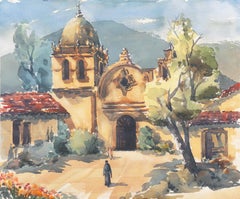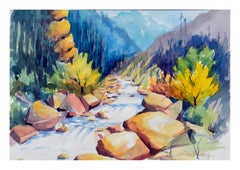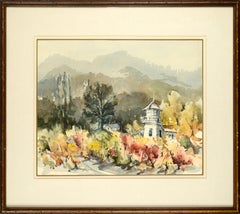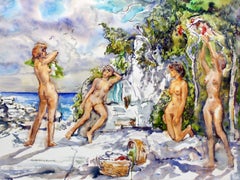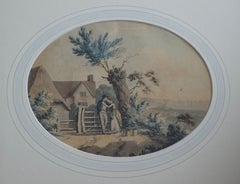Henry Hank Volle Landscape Drawings and Watercolors
American
Hank Volle received his college training at the University of Illinois and abroad at the Klinger Institute in Vienna, Austria. His business career in advertising and marketing has been interwoven with a love of expression in watercolors — he studied and painted with leading watercolorists in the San Francisco Bay Area and in the Midwest. Volle paints on location and his paintings are displayed in Bay Area galleries and private collections in the West and elsewhere around the United States. He is an active member of the Santa Clara Valley Watercolor Society and the Society of Western Artists. He lives and paints at "The Villages" in the Evergreen Foothills in San Jose, California.to
2
1
1
1
Overall Width
to
Overall Height
to
3
2
1
1
3
1
1
1
1
1
1
3
3
3
1
4
143
123
66
60
2
3
Artist: Henry Hank Volle
'Carmel Mission', Santa Clara, California, Society Western Artists, Historical
By Henry Hank Volle
Located in Santa Cruz, CA
Signed lower right, 'Henry Volle' (American, 20th century) and painted circa 1975.
A substantial and lyrically painted watercolor view of the original Spanish colonial church and ...
Category
1970s Henry Hank Volle Landscape Drawings and Watercolors
Materials
Watercolor, Laid Paper
Mountain River Watercolor Landscape
By Henry Hank Volle
Located in Soquel, CA
Colorful mountain river watercolor painting by Henry "Hank" Volle (American, 20th Century). Signed "Henry Volle" lower right. Artists bio on verso. Pre...
Category
1970s American Impressionist Henry Hank Volle Landscape Drawings and Watercolors
Materials
Paper, Watercolor
$460 Sale Price
20% Off
Mountain Vineyard Landscape Watercolor
By Henry Hank Volle
Located in Soquel, CA
Beautiful watercolor landscape of a white farmhouse beside a colorful California vineyard with tall mountains fading into the distance Henry Hank Volle (American, 20th Century). This scene was painted on Hecker Pass in the Santa Cruz mountains...
Category
Late 20th Century American Modern Henry Hank Volle Landscape Drawings and Watercolors
Materials
Paper, Watercolor
$700 Sale Price
20% Off
Related Items
Nude Picnic Virgin Islands
By Robert Noel Blair
Located in Buffalo, NY
Robert Noel Blair (American, 1912-2003) was an American artist, painter, sculptor, printmaker and teacher. He is best known for his rural life & desert landscapes and World War II sc...
Category
1960s American Modern Henry Hank Volle Landscape Drawings and Watercolors
Materials
Archival Paper, Watercolor
English School, circa 1800 Georgian watercolor, The Sailor's return
Located in Harkstead, GB
A delightful rustic scene dating to circa 1800 with the sailor returning to his thankful wife and the domestic idyll of his country cottage. The harbour with sailing ships ferrying c...
Category
Early 19th Century Romantic Henry Hank Volle Landscape Drawings and Watercolors
Materials
Watercolor, Laid Paper
$265 Sale Price
30% Off
H 6.5 in W 8.5 in D 1 in
Rainstorm Sunset
By Robert Noel Blair
Located in Buffalo, NY
You are viewing a modernist American watercolor painting by Robert Noel Blair.
Robert Noel Blair (American, 1912-2003) was an American artist, painter, sculptor, printmaker and te...
Category
American Modern Henry Hank Volle Landscape Drawings and Watercolors
Materials
Paper, Watercolor
"NY Street Signs" Mid-20th Century WPA 1938 Modernist Abstract Realism Pop Art
By Stuart Davis
Located in New York, NY
"NY Street Signs" Mid-20th Century WPA 1938 Modernist Abstract Realism Pop Art
Stuart Davis (American, 1892-1964) "Street Signs" Modernist gouache and traces of pencil on paper in the proto-pop art style Davis is celebrated for, 1938, signed to lower right, framed. Image: 11 1/4 x 15 1/4 inches. Frame by Bark: 18 1/2 x 22 inches.
LITERATURE: A, Boyajian, M. Rutkowski, Stuart Davis, A Catalogue Raisonne, Vol. 2, New Haven, Connecticut, 2007, vol. II, p. 632, no. 1232, illustrated.
EXHIBITIONS: ACA Galleries, New York American Artists' Congress: Group Exhibition of Paintings and Sculpture, Dec. 3-16, 1939 (SDAB I, 12/3/39, p. 129). Outlines Gallery, Pittsburgh, Stuart Davis, Mar. 3-16, 1946. Coleman Art Gallery, Philadelphia, 5 Prodigal Sons: Former Philadelphia Artists: Ralston Crawford, Stuart Davis, Charles Demuth, Julian Levi, Charles Sheeler, Oct 4 - 30, 1947 (pamphlet), no. 12.
PROVENANCE: The artist; Mr. and Mrs. Frank Bowles, New York, Apr. 3, 1956; thence by descent, Private Collection, New York.
NOTES: According to the Catalogue Raissonne, "the title 'Street Signs' is recorded in the artist's account books...
Category
1930s American Modern Henry Hank Volle Landscape Drawings and Watercolors
Materials
Paper, Gouache, Pencil
$125,000
H 18.5 in W 22 in D 1 in
Pretty Woman in a Red & White Dress with Flowers in Her Bonnet (Impressionist)
By Lucius Rossi
Located in Rancho Santa Fe, CA
Lucius Rossi (1846-1913) was an Italian portrait and figurative painter who worked and lived in Paris. He was a friend and painter of many of the High Society people in Paris. A pain...
Category
Late 19th Century Impressionist Henry Hank Volle Landscape Drawings and Watercolors
Materials
Watercolor, Laid Paper
$1,700
H 12.75 in W 8.75 in
Mid Century "Napa Valley Landscape" Watercolor Painting
By Frederick Pomeroy
Located in Arp, TX
Frederick Pomeroy
"Napa Valley Landscape"
c. 1960s
Watercolor on paper
17"x14" brown wood frame float mount over linen mat
Signed in paint lower ...
Category
1960s American Modern Henry Hank Volle Landscape Drawings and Watercolors
Materials
Watercolor, Archival Paper
$600
H 14 in W 17 in D 0.5 in
Mill with Masted Ships in a Harbor Original Watercolor
Located in Soquel, CA
Mill with Masted Ships in a Harbor Original Watercolor
Early Watercolor of a coastal Mill with Schooners in a harbor, by an unknown artist. 1890-1915. The image depicts a watercolor...
Category
Late 19th Century Impressionist Henry Hank Volle Landscape Drawings and Watercolors
Materials
Watercolor, Laid Paper
$747 Sale Price
35% Off
H 16 in W 14 in D 0.08 in
"Train Station, " Max Kuehne, Industrial City Scene, American Impressionism
By Max Kuehne
Located in New York, NY
Max Kuehne (1880 - 1968)
Train Station, circa 1910
Watercolor on paper
8 1/4 x 10 1/4 inches
Signed lower right
Provenance:
Private Collection, Illinois
Max Kuehne was born in Halle, Germany on November 7, 1880. During his adolescence the family immigrated to America and settled in Flushing, New York. As a young man, Max was active in rowing events, bicycle racing, swimming and sailing. After experimenting with various occupations, Kuehne decided to study art, which led him to William Merritt Chase's famous school in New York; he was trained by Chase himself, then by Kenneth Hayes Miller. Chase was at the peak of his career, and his portraits were especially in demand. Kuehne would have profited from Chase's invaluable lessons in technique, as well as his inspirational personality. Miller, only four years older than Kuehne, was another of the many artists to benefit from Chase's teachings. Even though Miller still would have been under the spell of Chase upon Kuehne's arrival, he was already experimenting with an aestheticism that went beyond Chase's realism and virtuosity of the brush. Later Miller developed a style dependent upon volumetric figures that recall Italian Renaissance prototypes.
Kuehne moved from Miller to Robert Henri in 1909. Rockwell Kent, who also studied under Chase, Miller, and Henri, expressed what he felt were their respective contributions: "As Chase had taught us to use our eyes, and Henri to enlist our hearts, Miller called on us to use our heads." (Rockwell Kent, It's Me O Lord: The Autobiography of Rockwell Kent. New York: Dodd, Mead and Co., 1955, p. 83). Henri prompted Kuehne to search out the unvarnished realities of urban living; a notable portion of Henri's stylistic formula was incorporated into his work.
Having received such a thorough foundation in art, Kuehne spent a year in Europe's major art museums to study techniques of the old masters. His son Richard named Ernest Lawson as one of Max Kuehne's European traveling companions. In 1911 Kuehne moved to New York where he maintained a studio and painted everyday scenes around him, using the rather Manet-like, dark palette of Henri.
A trip to Gloucester during the following summer engendered a brighter palette. In the words of Gallatin (1924, p. 60), during that summer Kuehne "executed some of his most successful pictures, paintings full of sunlight . . . revealing the fact that he was becoming a colorist of considerable distinction." Kuehne was away in England the year of the Armory Show (1913), where he worked on powerful, painterly seascapes on the rocky shores of Cornwall. Possibly inspired by Henri - who had discovered Madrid in 1900 then took classes there in 1906, 1908 and 1912 - Kuehne visited Spain in 1914; in all, he would spend three years there, maintaining a studio in Granada. He developed his own impressionism and a greater simplicity while in Spain, under the influence of the brilliant Mediterranean light. George Bellows convinced Kuehne to spend the summer of 1919 in Rockport, Maine (near Camden). The influence of Bellows was more than casual; he would have intensified Kuehne's commitment to paint life "in the raw" around him.
After another brief trip to Spain in 1920, Kuehne went to the other Rockport (Cape Ann, Massachusetts) where he was accepted as a member of the vigorous art colony, spearheaded by Aldro T. Hibbard. Rockport's picturesque ambiance fulfilled the needs of an artist-sailor: as a writer in the Gloucester Daily Times explained, "Max Kuehne came to Rockport to paint, but he stayed to sail." The 1920s was a boom decade for Cape Ann, as it was for the rest of the nation. Kuehne's studio in Rockport was formerly occupied by Jonas Lie.
Kuehne spent the summer of 1923 in Paris, where in July, André Breton started a brawl as the curtain went up on a play by his rival Tristan Tzara; the event signified the demise of the Dada movement. Kuehne could not relate to this avant-garde art but was apparently influenced by more traditional painters — the Fauves, Nabis, and painters such as Bonnard. Gallatin perceived a looser handling and more brilliant color in the pictures Kuehne brought back to the States in the fall. In 1926, Kuehne won the First Honorable Mention at the Carnegie Institute, and he re-exhibited there, for example, in 1937 (Before the Wind). Besides painting, Kuehne did sculpture, decorative screens, and furniture work with carved and gilded molding. In addition, he designed and carved his own frames, and John Taylor Adams encouraged Kuehne to execute etchings. Through his talents in all these media he was able to survive the Depression, and during the 1940s and 1950s these activities almost eclipsed his easel painting. In later years, Kuehne's landscapes and still-lifes show the influence of Cézanne and Bonnard, and his style changed radically.
Max Kuehne died in 1968. He exhibited his work at the National Academy of Design, the Art Institute of Chicago, the Carnegie Institute in Pittsburgh, the Memorial Art Gallery of the University of Rochester, and in various New York City galleries. Kuehne's works are in the following public collections: the Detroit Institute of Arts (Marine Headland), the Whitney Museum (Diamond Hill...
Category
1910s American Impressionist Henry Hank Volle Landscape Drawings and Watercolors
Materials
Paper, Watercolor
$2,800 Sale Price
20% Off
H 13.5 in W 15.5 in
6th Avenue El at 8th St NYC Cityscape American Scene Social Realism Mid-Century
By Max Arthur Cohn
Located in New York, NY
6th Avenue El at 8th St NYC Cityscape American Scene Social Realism Mid-Century
Max Arthur Cohn (1903-1998)
6th Avenue El at 8th Street
13 x 18 inches
Watercolor on paper, c. 1930
...
Category
1930s American Modern Henry Hank Volle Landscape Drawings and Watercolors
Materials
Paper, Watercolor
“Rocky Mountain Meadow”
By Werner Drewes
Located in Southampton, NY
Original watercolor on archival paper of a Rocky Mountain Meadow by the well known American artist, Werner Drewes. Signed lower right. Titled and dated 1956 on verso of sheet. Con...
Category
1950s American Modern Henry Hank Volle Landscape Drawings and Watercolors
Materials
Watercolor, Archival Paper
Gold Rush Town Columbia, California Landscape by Lillie Heebner
By L. Heebner
Located in Soquel, CA
Colorful figurative landscape watercolor painting of Columbia, California, showing two men in cowboy hats. By Lillie Eesther (Hillman) Heebner, a Monterey Bay area artist. Signed "L....
Category
1970s American Impressionist Henry Hank Volle Landscape Drawings and Watercolors
Materials
Watercolor, Laid Paper
$268 Sale Price
20% Off
H 15 in W 23 in D 0.1 in
Mid Century Modern Painting American interior table scape Framed Red Stripe B&W
Located in Buffalo, NY
Dorothy Rivo
Still Life with Striped Wall
Acrylic on panel
Framed dimensions: 24 in. H × 26 in. W
Contemporary black frame
Dorothy Rivo’s Still Life with Striped Wall distills the s...
Category
Mid-20th Century American Modern Henry Hank Volle Landscape Drawings and Watercolors
Materials
Watercolor, Archival Paper
Henry Hank Volle landscape drawings and watercolors for sale on 1stDibs.
Find a wide variety of authentic Henry Hank Volle landscape drawings and watercolors available for sale on 1stDibs. You can also browse by medium to find art by Henry Hank Volle in paint, paper, watercolor and more. Much of the original work by this artist or collective was created during the 20th century and is mostly associated with the Impressionist style. Not every interior allows for large Henry Hank Volle landscape drawings and watercolors, so small editions measuring 24 inches across are available. Customers who are interested in this artist might also find the work of James March Phillips, Greta Allen, and Eve Nethercott. Henry Hank Volle landscape drawings and watercolors prices can differ depending upon medium, time period and other attributes. On 1stDibs, the price for these items starts at $431 and tops out at $2,750, while the average work can sell for $700.
